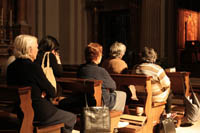|
|
 Twenty years of performing weddings, funerals, communions and baptisms have made Don Nazareno Bartolucci a steadfast pillar of faith in Cagli. His calm nature and gentle eyes show none of the strain of carrying the town’s faith on his shoulders. His tiny figure engulfed in his priestly robes standing in the pulpit belies the intense passion that comes through in his voice booming out his prayers. Twenty years of performing weddings, funerals, communions and baptisms have made Don Nazareno Bartolucci a steadfast pillar of faith in Cagli. His calm nature and gentle eyes show none of the strain of carrying the town’s faith on his shoulders. His tiny figure engulfed in his priestly robes standing in the pulpit belies the intense passion that comes through in his voice booming out his prayers.
The Cattedrale Santa Maria Assunte, the center of religion in Cagli, is located in the Piazza Matteotti, the center of commerce, entertainment and government. In a country whose name is almost synonymous with Catholicism, churches in Italy are steeped in tradition and history, as well as faith.
In the northeast corner of the piazza, down a narrow main street that is characteristic of Old Cagli, there is an archway on the side of a building. Across from the entrance of Caffé del Corso, a popular nightclub and restaurant, remain some of the original church of Cagli. Built in 1440, the arch, which is no longer a doorway, shows what was the entrance of the first church.
Inside an obscure doorway a little farther down, Don Nazareno’s office can be found. His pride and attention are not limited to his flock. He is active in maintaining the 15 churches in Cagli, remnants of the Middle Ages when there was a church in every quarter. Today, they are open only to show off their historical and architectural prizes. Don Nazareno explained that the cathedral is the main church and the only one where services are regularly held.
|
 |
|
 A cathedral must be the seat of the bishop, but Cagli’s bishop is not in residence. “This is the seat of the bishop, although he currently lives in Fano because of health problems,” he says. A cathedral must be the seat of the bishop, but Cagli’s bishop is not in residence. “This is the seat of the bishop, although he currently lives in Fano because of health problems,” he says.
There is a large ornately carved wooden chair, the cathedral, to the left of the pulpit where he sits in when he visits.
The outside of the building is not ornamented like to the well-known cathedrals of the Duomo in Florence or St. Peter’s Basilica in Rome, but is actually remarkably plain. Larger and plainer even than the buildings around it, it has only the worn stones to give it any character.
Inside, the ceiling is three stories high and has religious paintings running the length of it. Massive piers separate the nave into three parts. The width is the former length of the original church built on the site in 1292. It was enlarged in 1676. Walking down the original stone floor, Don Nazareno looks more like a school principal than a parish priest with his bifocals, navy sweater and hands clasped behind his back.
While describing the history of the pulpit, which also dates back to the 1600s, and pointing out restored frescoes from the original 1292 church, he launches into a story. It was June 3, 1781. The church was packed with people attending Mass. The ground started trembling. Before people could shelter themselves, the stone walls and ceiling began to fall. By the time all the debris and stones were removed days later, the death toll had reached 75.
|
 |
|
 Although that dark day is remembered, the tragedy did not bring the Cagliese down. The cathedral was soon rebuilt. “Another earthquake in 1997, luckily did not do as much damage,” he added. Although that dark day is remembered, the tragedy did not bring the Cagliese down. The cathedral was soon rebuilt. “Another earthquake in 1997, luckily did not do as much damage,” he added.
The passion for keeping the history alive is evident in Don Nazareno’s knowledge of every detail of every stone, every fresco and every event that took place in the church.
Unlike many other historical churches in Italy, the Cattedrale Santa Maria Assunta and the other churches of Cagli do not charge an entrance fee.
The devout, who attend Mass daily, see the cathedral as not only a historical site that needs to be preserved, but also as their place to worship God and to meet other Catholics. The building transcends any role as a tourist attraction to remain a refuge for those who seek Don Nazareno’s wisdom and an understanding of Christ’s love.
In the mornings at 9, people can be seen entering the narrow wooden door for Mass. From the pulpit built in the 1600s, Don Nazareno can be heard singing and giving Communion. The stones and paintings transcend time and sanctify space. With heads bent in prayer and the priest in his robes, this could be 1706 as easily as 2006.
An elderly woman sits in the pew leaning forward on her cane because she can no longer kneel. She hobbles to the church every morning to say her prayers. It is partly tradition that brings her, partly habit, but mostly her faith.
The Cattedrale Santa Maria Assunta is preserved because it is more than a museum. It holds the past, present and future of religious faith in Cagli.
[HOME]
|
 |
 |
|
 |
